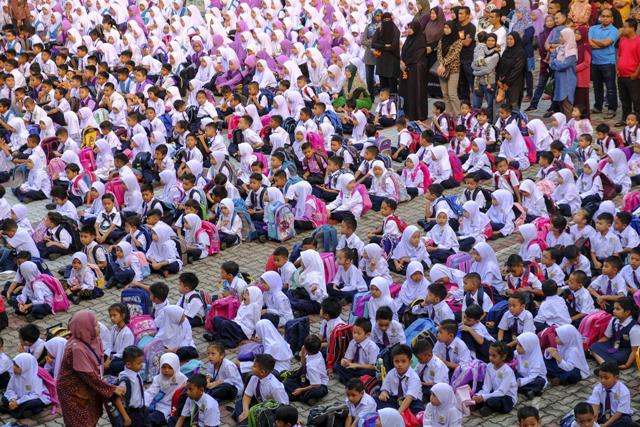 First day at Sk Seri Pristana school, Kuala Lumpur in January 2020. Parents and students attend. [photo: Alamy]
First day at Sk Seri Pristana school, Kuala Lumpur in January 2020. Parents and students attend. [photo: Alamy]
[This is an excerpt from an article in The Round Table: The Commonwealth Journal of International Affairs. Opinions expressed do not reflect the position of the editorial board.]
History textbook writing has been a controversial issue in Malaysia’s multi-ethnic society since 1996 with the publication of the Form 1 history textbook whose writers and consulting experts were all Malays, the dominant ethnic group. Whilst the Malay ethno-nationalist group has been promoting a ‘Malay and Islam-centric framework’, concerned non-Malays have been campaigning for a more inclusive and truthful history based upon a ‘Malaysia-centric framework’.
The latest edition of secondary history textbooks in Malaysia, beginning with the publication of the Form 1 history textbook in 2016 and that of the Form 5 textbook in 2020, are lopsided (distinctively Malay and Islam-centric) and biased (they intentionally omit significant facts relevant to nation-building). Seventeen out of the eighteen writers of the Forms 1–5 history textbooks are Malays. Hence, young Malaysians are now primarily learning government-sanctioned history specifically as viewed through the lens of one ethnic group and skewed towards establishing Islamic and Malay dominance based upon the divisive concept of ‘ketuanan Melayu’ (Malay supremacy).
Fundamentally, the history textbooks do not provide an adequate, balanced and fair account of the emergence and growth of Malaysia’s plural society. For example, unlike earlier textbooks, the current history textbooks downplay the important roles and contributions of the Malaysian Chinese and Indian communities in the economic and infrastructure development of the nation. The textbooks are virtually silent about the pioneering role of the Chinese in the development of commercial agriculture (pepper, gambier, tapioca and pineapple) in the Straits Settlements and Malay states during the nineteenth century. Astonishingly, the vital role of the Chinese in the development of the nation’s tin mining industry is dismissed off-hand in about 2–3 sentences in the Form 3 history textbook. In addition, the history textbooks make no mention of the singular role of Yap Ah Loy in developing early Kuala Lumpur whom the pre-eminent historian, J. M. Gullick has described as ‘Mr. Kuala Lumpur’ down to 1879.
Similarly, the contributions of Indians in the development of the Malayan rubber industry are scantly mentioned in just a couple of sentences in the Form 3 textbook. The history textbooks also omit the significant role of Indian labour in building roads, railways and bridges besides constructing ports, airports and government buildings. They sadly forget to tell the important, poignant story whereby hundreds of thousands of Indians lost their lives due to disease, snake bites, exhaustion and mal nutrition while helping to develop the infrastructure of modern Malaya.
Apart from biases and omissions, the history textbooks also contain factual distortions and exaggerations. For instance, the Form 4 history textbook erroneously states that the Malay regiment (numbering only about 1,400 men) formed the bulwark of British Malaya’s defence during the Japanese invasion of 1941–42 when in reality it was mainly the British, Indian and Australian troops who did so. The history textbooks also exaggerate the role of Malay chiefs in the economic development of British Malaya. For instance, the Form 3 textbook states incorrectly that Long Jaafar brought progress in Larut, Perak, and thereby introduced the Malay state to the world market as a major producer of tin. The truth is that it was primarily Chinese capital and labour that made the Federated Malay States become the world’s largest tin producer more than three decades after the death of Long Jaafar in 1857.
Notably, the teaching of history in schools based upon textbooks that are factually accurate, generally objective and inclusive plays a vital role in shaping young minds and in promoting a sense of national identity and belonging which is crucial for racial harmony and national unity in a multi-ethnic nation such as Malaysia. This sense of belonging and identity based upon a shared memory of the nation is a vital prerequisite for the future success and wellbeing of Malaysia in today’s highly competitive and challenging world.
Ranjit Singh Malhi is an Independent Historian and Adjunct Professor, Asia Pacific University of Technology and Innovation, Kuala Lumpur, Malaysia.



